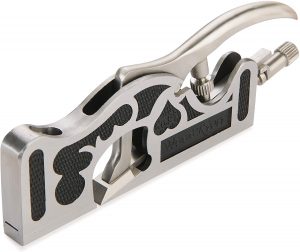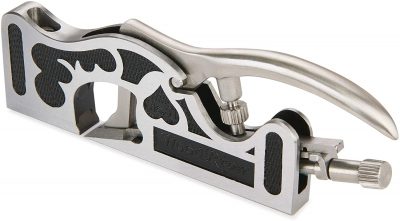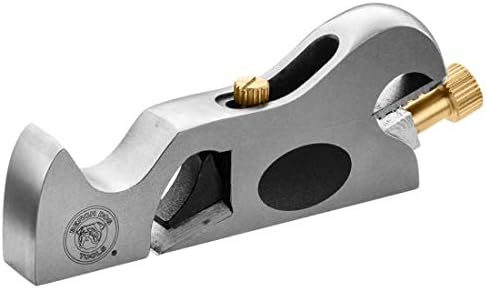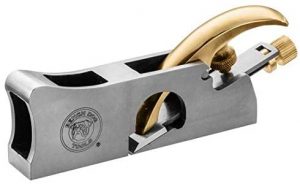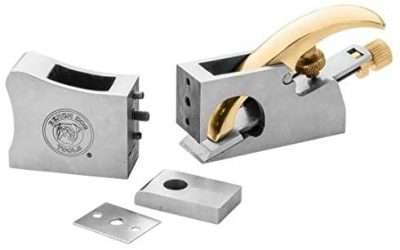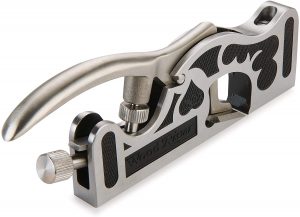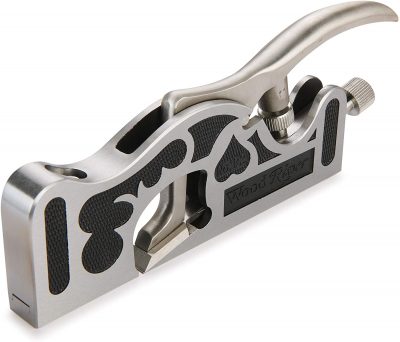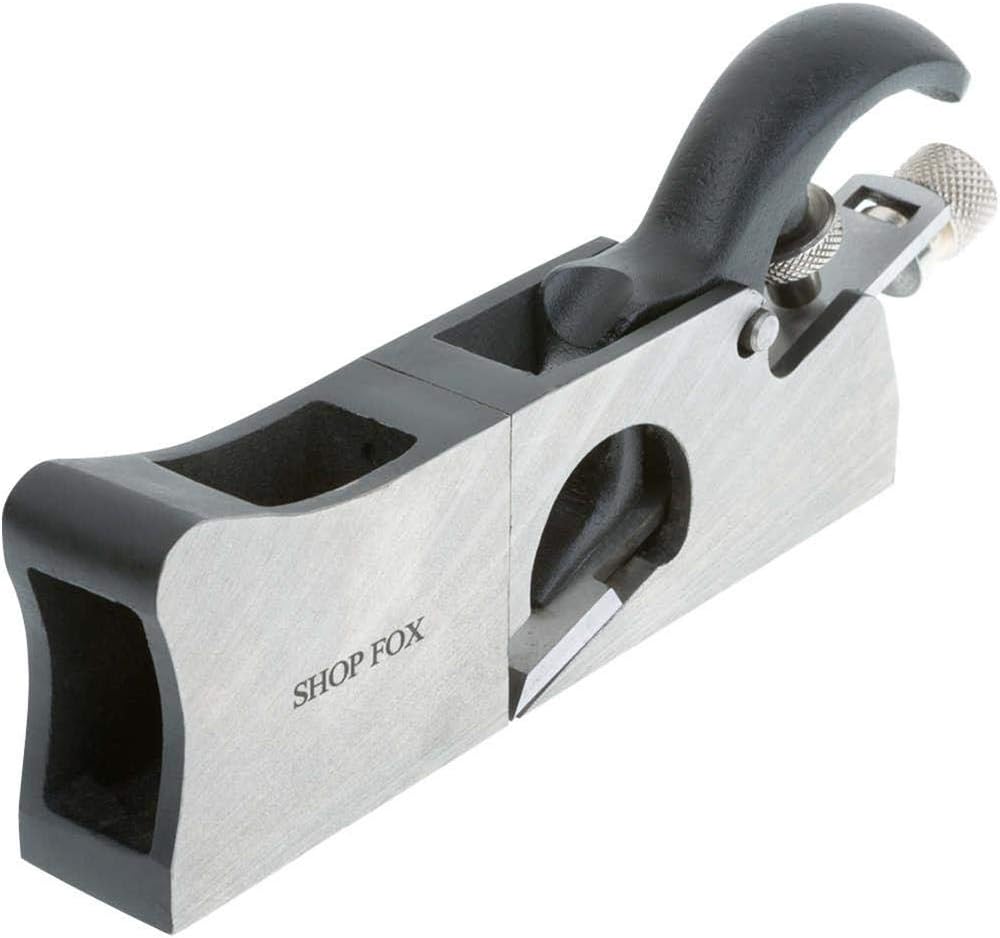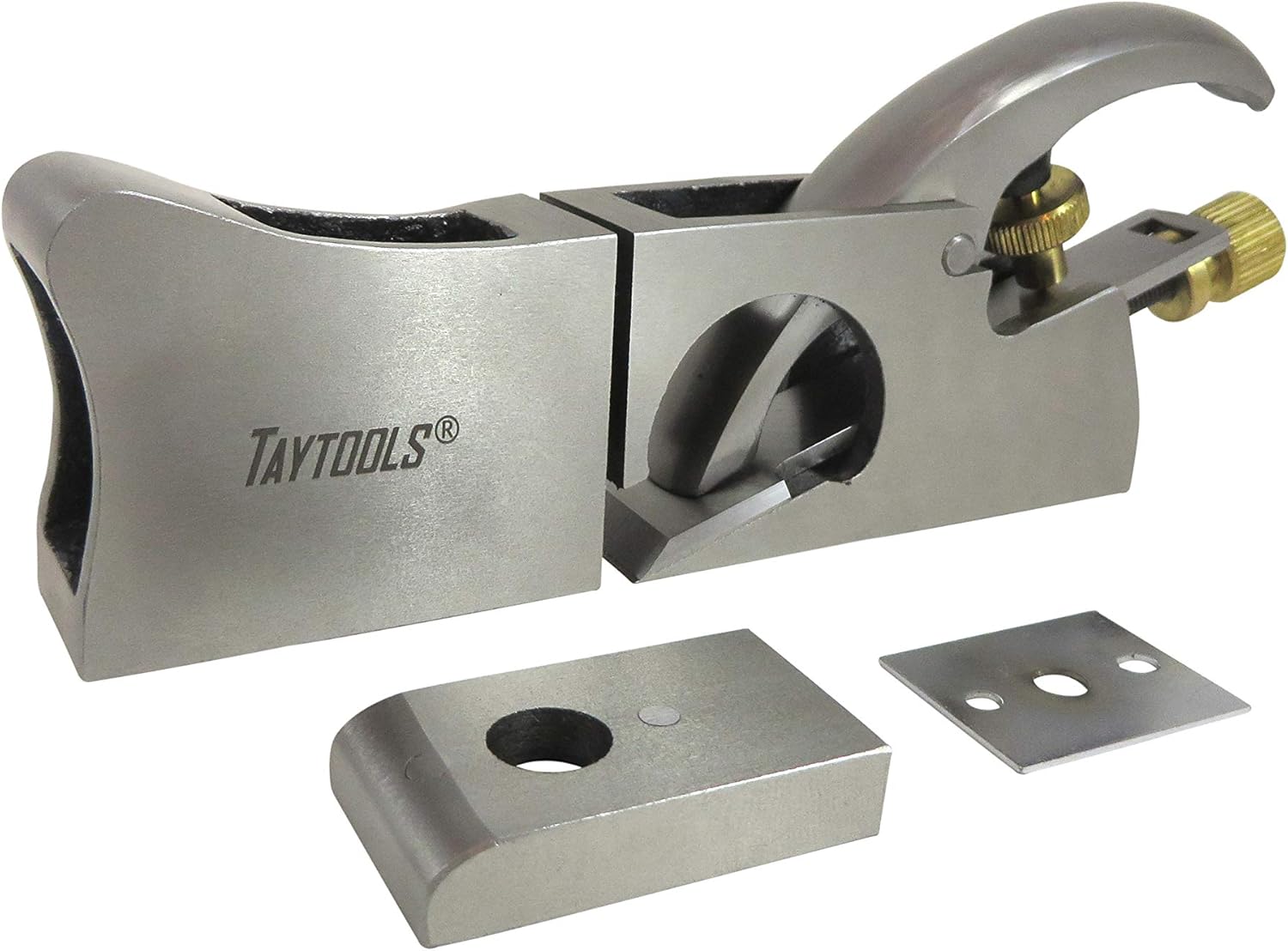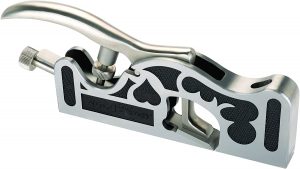Shoulder Planes Worth Your Attention for 2026
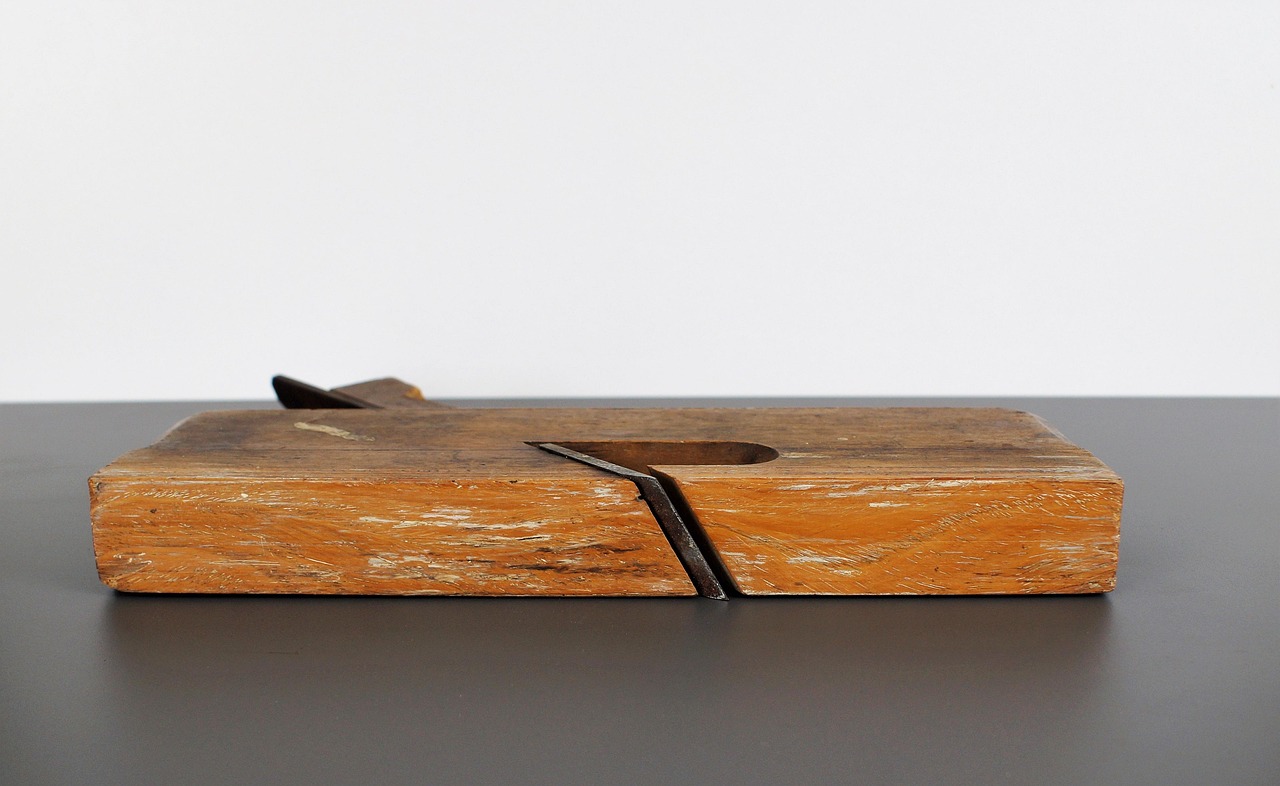
There's something oddly satisfying about watching a shoulder plane slice through the end grain of a tenon. The blade sits nearly flush with the body, cutting right up to corners where other planes fear to tread. It's precision work, the kind that separates furniture that lasts from furniture that merely exists.
A shoulder plane does what most other tools can't: it trims perpendicular shoulders and tenon faces with absolute accuracy. The blade extends the full width and length of the tool, reaching into corners that would leave other hand planes stranded. That's why carpenters reach for these when fitting mortise and tenon joints, cleaning up rabbets, or working dadoes where tolerance matters.
The tool itself looks deceptively simple. Cast iron body, narrow profile, blade bedded at a low angle. But the engineering tells a different story. The sides must be perfectly square to the sole, the blade needs to sit just proud of the body edges, and the throat opening has to be adjustable enough to prevent tearout without choking on shavings. Get any of that wrong and you're not trimming shoulders, you're making firewood.
We've spent time with several shoulder planes, from compact models that fit in your palm to larger versions that need both hands. Some convert into chisel planes when you need to reach into tight spots. Others stay dedicated to one job and do it exceptionally well. The differences matter more than you'd think.
What follows isn't a ranking. It's a look at shoulder planes that actually work, organized by what they're built to do and how they handle real joinery tasks. Whether you're fitting your first tenon or your thousandth, the right tool makes the difference between joints that fit and joints that don't.
WoodRiver No. 91 Small Shoulder Plane
WoodRiver No. 91 Small Shoulder Plane
- Body: Cr40 stress-relieved ductile steel
- Blade: Mn65 hardened to HRC60-64
- Width: 1/2 inch
- Length: 6-1/2 inches
- Adjustable toe for throat control
WoodRiver took the Edward Preston and Sons design from another era and added what modern metalworking can do. The result sits somewhere between vintage toolmaking and contemporary precision. The narrow body and slightly proud blade follow that classic pattern where the cutting edge extends just past the body's width, leaving clean corners without ridges.
The body comes from Cr40 stress-relieved ductile steel, machined flat and square. That's not marketing language. It means the sides actually meet the sole at ninety degrees, which matters when you're trimming tenons that need to fit. The blade is Mn65 tool steel hardened to HRC60-64, a specification that translates to edge retention through hardwoods without constant trips to the sharpening stone.
One detail separates this from pure vintage reproduction: the adjustable toe. Move it forward and you open the throat for heavier cuts. Pull it back and the tighter opening reduces tearout on end grain. It's a modern addition to an old design, the kind of update that makes sense once you've fought with tearout on figured maple.
The plane beds at 15 degrees with a 25-degree blade bevel, creating a 40-degree cutting angle. At 6-1/2 inches long and 1/2 inch wide, it fits into spaces where larger planes can't reach. The 3/4 body length gives you enough mass for control without the bulk that gets in the way on smaller joinery.
This is the smallest of WoodRiver's shoulder plane lineup, built for dados, rabbets, and tenon cleanup where size constraints matter. The antique aesthetic isn't an accident. It's what happens when you machine modern steel to historical dimensions and don't compromise on either.
Bench Dog No. 92 Shoulder Plane
Bench Dog No. 92 Shoulder Plane
- Body: Cast iron, precision machined
- Blade: 3/4 inch hardened carbon steel
- Cutting depth: 0.13 inches
- Removable nose pieces (long and short)
- Includes storage case and certificate of inspection
Bench Dog built this one with conversion in mind. Remove the front section and you have a chisel plane that reaches into corners where the full body can't go. The upper nose section comes off entirely, giving you direct access to tight spots in joinery. Two nose pieces come with it, long and short, each changing how the plane handles different situations.
The 3/4 inch blade sits slightly wider than the body, just enough that sharp corners stay clean without leaving material behind. Both the sole and the blade back go through precision grinding and polishing, the kind of attention that shows up when you flip the tool over and actually look at the surfaces. They're flat, which matters more than any marketing copy could explain.
Cast iron construction with brass adjustment hardware gives the plane enough heft to stay controlled through cuts. Finger recesses along the sides create natural grip points where your hands want to hold it anyway. The design doesn't fight how you naturally pick up a narrow-bodied plane.
Every Bench Dog No. 92 ships with a certificate stating the specific measurements for that individual plane, sole flatness and blade hardness both documented. The storage case that comes with it isn't just packaging. It's a wooden box built to protect the tool between uses, the kind of container that suggests the manufacturer expects this plane to last decades.
The 5.25 inch length puts it between the smallest shoulder planes and the full-size workhorses. That middle ground covers most joinery work without the bulk of larger models. The conversion system means you're carrying what amounts to three different tools, though calling it that undersells how quickly the nose pieces swap.
Bench Dog Tools 3-in-1 Shoulder Plane
Bench Dog Tools 3-in-1 Shoulder Plane
- Blade: 1 inch (slightly wider than body)
- Cast iron body with precision ground sole
- Removable long and short nose pieces
- Includes storage case and certificate of inspection
- Sides machined square to sole
The wider blade here changes what the plane can handle. At 1 inch across, it covers more ground than the 3/4 inch models while keeping the same conversion capability. Pop off the long nose and you have a shoulder plane. Remove it entirely and you're working with a chisel plane. Add the short nose and you've got a bullnose plane that reaches into stopped dados.
Bench Dog machines the sides square to the sole and grinds both flat before the planes leave the factory. The blade gets the same treatment, precision ground and polished on the back. That 1 inch blade extends just past the body's edges, leaving clean corners without ridges where the cut stops.
The cast iron construction follows the same pattern as other Bench Dog planes, with enough mass to dampen vibration without becoming unwieldy. Each plane comes with its own certificate documenting the sole flatness and blade hardness measurements, specific to that individual tool. The storage case isn't an afterthought. It's a proper wooden box designed to keep the plane protected when it's not in your hands.
The conversion system works without tools or complicated procedures. The nose pieces attach and detach quickly enough that switching between configurations doesn't interrupt workflow. That matters more than it sounds when you're moving between different joints on the same project.
WoodRiver #92 Medium Shoulder Plane
WoodRiver #92 Medium Shoulder Plane
- Body: Cr40 stress-relieved ductile steel
- Blade: Mn65 tool steel, HRC60-64
- Width: 3/4 inch
- Length: 8-13/16 inches
- Weight: 2.35 lbs
- Adjustable toe, 15° bed angle, 25° blade angle
The medium WoodRiver sits between their small and large models at just under 9 inches long. That extra length translates to more surface contact on longer tenons and wider rabbets. At 2.35 pounds, it carries enough weight to maintain momentum through cuts without the heft that makes your hand tired after an hour of fitting joints.
Like the smaller No. 91, this follows the Edward Preston design language while incorporating modern manufacturing precision. The narrow body, slightly proud blade, and flat bottom all echo patterns from an earlier era of toolmaking. The adjustable toe came later, a practical addition that controls throat opening without redesigning the entire tool.
Cr40 ductile steel forms the body, machined flat and square before it leaves the factory. The Mn65 blade hardened to HRC60-64 holds an edge through extended use. That bedding angle of 15 degrees combined with the 25-degree blade bevel creates a 40-degree cutting angle, the same geometry that's been trimming tenons since before power tools existed.
The 3/4 inch width matches standard mortise and tenon work without being so narrow it wanders in the cut or so wide it can't reach into tighter spots. The blade extends just past the body edges, that fraction of an inch that prevents ridges at the corners of your cuts. It's precision machining serving a specific purpose rather than just tight tolerances for their own sake.
Woodstock D3752 3-In-1 Shoulder Plane
Woodstock D3752 3-In-1 Shoulder Plane
- Width: 1-3/32 inches
- Length: 6 inches
- Weight: 2.36 lbs
- Low angle design
- Converts to chisel plane or bullnose plane
- Knurled adjustment screw
At just over an inch wide, the Woodstock covers more surface area than most shoulder planes while staying compact enough for detailed work. The 1-3/32 inch sole gives you stability across wider tenon faces and rabbets without the length that makes some planes unwieldy in tight spots.
The conversion system follows the same pattern as other three-in-one designs. Remove sections of the nose and you shift from shoulder plane to bullnose to chisel plane. The knurled adjustment screw makes blade depth changes without reaching for tools. Simple mechanics that work reliably beat complicated systems that need constant adjustment.
The full-width blade extends across the sole, removing material right up to both edges of the cut. That matters when you're cleaning up joinery where even a thin ridge left behind means the joint won't close properly. The low angle design handles end grain without the tearout that plagues higher-angle planes in cross-grain situations.
At 2.36 pounds and 6 inches long, the Woodstock balances weight and maneuverability. Heavy enough to maintain control, light enough that extended sessions of joint fitting don't wear you down. The tool removes material efficiently without requiring constant blade adjustments or fighting to keep the cut straight.
Taytools 469225 3-in-1 Shoulder Plane
Taytools 469225 3-in-1 Shoulder Plane
- Body: Ductile cast iron with precision ground sole
- Blade: 1 inch, 0.110 inches thick
- Length: 7-1/2 inches
- Weight: 2 lbs
- Blade hardness: 55-60 HRc
- Bed angle: 20 degrees, bevel: 25 degrees
- Includes front extension, nose piece, and shim
Taytools built this one with a thicker blade than most shoulder planes carry. That 0.110 inch thickness resists flexing under pressure, keeping cuts consistent even when you're removing material aggressively. The 1 inch width covers substantial ground while the 7-1/2 inch length gives you enough sole contact for stability.
The ductile cast iron body gets precision grinding on the sole and sides before the edges receive their blackened finish. That grinding process ensures the sides meet the sole at proper right angles, the kind of dimensional accuracy that separates planes that work from planes that frustrate. The blade itself receives lapping on both the 25-degree bevel and the flat back, arriving with edges ready for use.
Three configurations come standard: install the front extension piece and you have a full shoulder plane, remove it for chisel plane work, add the nose piece for bullnose operation. The included shim lets you adjust the mouth opening when different materials or cut depths require it. Simple mechanical solutions that work without complex adjustment systems.
The 20-degree bed angle positions the blade slightly higher than the 15-degree standard on some other shoulder planes. Combined with the 25-degree bevel, you get a 45-degree cutting angle that handles a wider range of wood species without modification. The hardened tool steel blade at 55-60 HRc strikes a balance between edge retention and ease of sharpening.
At 2 pounds, the Taytools carries enough mass to cut smoothly without the bulk that makes detailed work awkward. The knurled adjustment screw changes blade depth without interrupting your workflow. The polished finish isn't purely cosmetic, it reduces friction and makes the plane easier to clean when wood dust and shavings accumulate.
WoodRiver No. 93 Large Shoulder Plane
WoodRiver No. 93 Large Shoulder Plane
- Body: Cr40 stress-relieved ductile steel
- Blade: Mn65 tool steel, HRC60-64
- Width: 1 inch
- Length: 10-7/16 inches
- Weight: 3 lbs 12.8 oz
- Adjustable toe, 15° bed, 25° blade bevel
The largest in WoodRiver's shoulder plane line stretches past 10 inches and weighs nearly 4 pounds. That size matters when you're working substantial joinery where smaller planes require multiple passes or lose registration on longer surfaces. The sole contact area keeps cuts true across extended tenon faces that would challenge shorter tools.
This follows the same Edward Preston design heritage as the smaller WoodRiver models, scaled up for larger work. The narrow body, slightly proud blade, and adjustable toe all carry over, just stretched to dimensions that handle full-scale furniture joinery. The Cr40 ductile steel body gets machined flat and square, while the Mn65 blade hardened to HRC60-64 maintains its edge through extended sessions.
At 1 inch wide, the No. 93 matches the capacity of the wider three-in-one planes while keeping the dedicated shoulder plane geometry. No conversion pieces, no alternative configurations. This tool does one job at substantial scale and the weight backs that up. Nearly 4 pounds means it cuts with momentum, reducing the effort needed to push through hardwoods.
The 15-degree bed angle and 25-degree blade bevel create the same 40-degree cutting geometry found across WoodRiver's line. The adjustable toe controls throat opening for different cut depths and wood species. That classic design language works at this scale because the fundamentals of cutting shoulders and trimming tenons don't change whether you're working drawer components or bed frame rails.
The size and weight position this plane for specific work. When joinery scales up to furniture that needs substantial tenons and wide shoulders, smaller planes become inadequate. The No. 93 exists for those situations where precision still matters but the work itself is simply bigger.
What Shoulder Planes Actually Do
The name tells you part of it. Shoulders in joinery are those perpendicular surfaces where the face of a tenon meets its shoulder, or where a rabbet makes its right-angle turn. Regular bench planes can't get into those corners. The blade doesn't extend far enough, the body gets in the way, or the angle is wrong for end grain work. Shoulder planes solve all three problems by design.
The blade runs the full width of the plane body and extends just slightly beyond both edges. This means when you plane a shoulder, you're cutting right into the corner where two surfaces meet. No ridge gets left behind. The narrow body fits into spaces where wider planes can't reach. The low bed angle, typically between 15 and 20 degrees, slices through end grain cleanly instead of crushing the fibers the way higher angles do.
Mortise and tenon joints benefit most obviously from shoulder planes. After cutting tenons, they rarely fit perfectly on the first try. The shoulder plane trims tenon faces and shoulders until the joint slides together with that satisfying resistance that means you got it right. Rabbets along board edges need the same kind of precise fitting, especially when you're matching pieces that have to align perfectly across their length.
Dadoes present similar challenges. You cut a groove across the grain, and now you need to fit a shelf or divider into it. Too tight and something splits. Too loose and the joint fails. The shoulder plane removes material in controlled amounts until the fit works. The low angle handles the cross-grain situation without tearout that would show in the finished piece.
The geometry matters more than it seems. That low bed angle puts the blade at an acute approach to the wood. Combined with the blade bevel, you get cutting angles typically between 40 and 45 degrees. This slices end grain fibers cleanly rather than tearing them. Block planes use similar angles for the same reason, though they're designed for different work.
The slightly proud blade isn't careless manufacturing. It's intentional. When the blade extends a fraction beyond the body edges, you cut a clean corner without leaving a step where the plane body stopped short. That tiny overhang makes the difference between joints that close properly and joints that have visible gaps.
Size Categories and What They Mean
Shoulder planes fall into rough size categories that correspond to different scales of work. The smallest ones, sometimes called bullnose or chisel planes when configured that way, typically measure 5 to 6-1/2 inches long with blade widths of 1/2 to 3/4 inch. These handle small joinery, detail work, and situations where space is constrained.
Medium shoulder planes run 7 to 9 inches long with similar blade widths, though some stretch to 1 inch wide. This middle ground covers most furniture joinery without the size penalty of larger models. They balance surface contact for stability against maneuverability in typical mortise and tenon work.
Large shoulder planes push past 10 inches and carry blades 1 inch wide or larger. These exist for substantial furniture work, timber framing details, or any situation where the joinery itself scales up to match the project. The additional sole length maintains accuracy over longer surfaces, while the width removes material faster.
The convertible models that swap between shoulder, chisel, and bullnose configurations typically sit in the small to medium range. The removable nose sections that enable conversion don't scale well to larger sizes where the additional bulk and complexity outweigh the versatility benefit. Dedicated large shoulder planes skip the conversion features entirely.
Weight correlates roughly with size but varies by construction. Cast iron planes carry more mass than stress-relieved steel equivalents of similar dimensions. That weight dampens vibration and helps maintain momentum through cuts, but also increases fatigue during extended work sessions. Planes under 2 pounds work well for detail fitting and smaller joinery. The 2 to 3 pound range handles most furniture work. Above 3 pounds, you're into tools meant for substantial joinery where the weight is necessary to keep cuts consistent through hardwoods.
Blade thickness matters alongside width. Thinner blades flex more easily under pressure, causing cuts to wander or chatter on difficult grain. Thicker blades resist flexing but take longer to sharpen when the edge dulls. Most shoulder planes use blades between 0.080 and 0.130 inches thick, with the heavier gauges appearing in larger models or planes designed for heavy stock removal.
The Adjustable Toe Detail
Many modern shoulder planes include an adjustable front section called the toe. This piece controls the throat opening, the gap in front of the blade where shavings exit. Opening the throat wider allows thicker shavings through, useful when removing material quickly. Closing it down restricts the throat to a narrow gap that supports wood fibers right at the cutting edge, reducing tearout on difficult grain.
The mechanism varies by manufacturer. Some toes adjust via a simple setscrew that moves the piece forward or backward. Others use dovetailed ways that let the toe slide with friction fit, secured by a thumbscrew once positioned. The adjustment range typically runs from nearly closed to about 1/16 inch, enough variation to handle different cutting situations without requiring blade changes or setup complexity.
This feature separates modern shoulder planes from pure vintage reproductions. Historical planes had fixed throats, chosen during manufacturing and unchangeable afterward. Woodworkers owned multiple planes with different throat openings for different work. The adjustable toe condenses that requirement into a single tool that adapts to varying conditions.
End grain work benefits most from a closed throat. When cutting across fibers, the tight opening supports the wood right at the cut, preventing the fibers from lifting and tearing ahead of the blade. Long grain and softer woods tolerate wider openings, where the main concern is clearing shavings before they clog the mouth and stop the cut.
The toe adjustment doesn't replace proper blade sharpening or correct technique. A dull blade tears wood regardless of throat opening. Poor planing angle or excessive pressure causes problems no mechanical adjustment can fix. But given a sharp blade and reasonable technique, throat control makes the difference between clean surfaces and damaged work that needs repair.
Materials and Manufacturing Methods
Cast iron remains the most common body material for shoulder planes. It machines cleanly, holds dimensional stability, provides natural vibration damping, and costs less than many alternatives. The casting process allows complex shapes like the narrow shoulder plane body with its precise internal geometries. Modern shoulder planes use either gray cast iron or ductile iron, with ductile variants offering higher strength and impact resistance.
Some manufacturers specify stress-relieved ductile steel instead of iron. The stress relief process involves heating the castings to specific temperatures then cooling them in controlled ways that eliminate internal stresses from the casting process. This prevents the body from warping over time or when subjected to machining operations. The material specification like Cr40 indicates the alloy composition that determines strength and machinability.
The sole and sides require precision grinding after casting. Flatness tolerances typically run between 0.001 and 0.003 inches across the sole length. The sides must meet the sole at exactly 90 degrees, with similar tight tolerances. These aren't aesthetic concerns. Deviations of even a few thousandths cause the plane to cut unevenly or fail to reference properly against the workpiece.
Blade steel varies more than body materials. Tool steels like Mn65 or A2 appear frequently, hardened to Rockwell ratings between 55 and 64 HRc. Higher hardness numbers mean better edge retention but more difficulty in sharpening. Lower numbers sharpen easily but dull faster. The range between 58 and 62 HRc balances these trade-offs for most users.
The blade manufacturing process affects performance as much as the steel choice. Precision grinding produces flat blade backs required for proper seating in the plane body. The bevel angle gets ground to specification, typically 25 degrees, though some users regrind this to suit their preferences. Lapping polishes both the bevel and back to reduce friction and improve edge quality.
Premium planes undergo individual inspection with measurements documented for each tool. Some manufacturers include certificates stating the actual sole flatness, side squareness, and blade hardness for that specific plane. This level of quality control separates production tools from precision instruments, though it comes with corresponding price differences.
The surface finish varies by manufacturer and price point. Some planes receive complete polishing, reducing friction and improving aesthetics. Others get blackened edges or oil finishes that protect the metal while leaving machined surfaces visible. Brass or bronze adjustment hardware appears on higher-end models, chosen for corrosion resistance and smoother operation than steel equivalents.
Frequently Asked Questions
What makes a shoulder plane different from a regular plane?
The blade extends the full width and length of the plane body, reaching into corners where standard bench planes can't go. The low bed angle, narrow body, and blade positioning all optimize for cutting perpendicular shoulders and end grain rather than dimensioning board faces.
Why are shoulder plane blades bedded at low angles?
Lower bed angles create acute cutting approaches that slice end grain fibers cleanly instead of crushing them. The typical 15 to 20 degree bed combined with a 25 degree bevel produces effective cutting angles between 40 and 45 degrees, suitable for cross-grain work.
What's the purpose of the slightly proud blade?
When the blade extends a fraction past the body edges, it cuts clean corners without leaving ridges where the plane body stops. This ensures joints close properly without visible gaps at the corners.
How does the adjustable toe work?
The toe controls the throat opening in front of the blade. A tighter throat supports wood fibers at the cutting edge, reducing tearout on difficult grain. Opening it wider allows thicker shavings through for faster material removal.
Why do some shoulder planes convert to chisel planes?
Removing the nose section lets you plane right into corners and stopped surfaces where even a shoulder plane's narrow body can't reach. The conversion adds versatility without requiring multiple dedicated tools.
What size shoulder plane handles most furniture joinery?
Planes between 7 and 9 inches long with 3/4 to 1 inch wide blades cover typical mortise and tenon work, rabbet fitting, and dado cleanup. Smaller planes suit detail work, while larger ones handle substantial timber joinery.
Does blade thickness matter?
Thicker blades resist flexing under cutting pressure, maintaining consistent depth and preventing chatter on difficult grain. Most shoulder planes use blades between 0.080 and 0.130 inches thick, with heavier gauges in larger models.
What's the difference between cast iron and ductile steel bodies?
Both materials machine precisely and provide vibration damping. Ductile steel offers higher strength and impact resistance than cast iron. Stress-relieved versions eliminate internal stresses that could cause warping over time.
Why do some planes specify steel hardness ratings?
Rockwell hardness numbers indicate how well the blade holds an edge versus how easily it sharpens. Ratings between 58 and 62 HRc balance edge retention with reasonable sharpening requirements for most users.
What does precision ground sole mean?
The bottom of the plane gets ground flat to within thousandths of an inch across its length. The sides are machined square to the sole at exactly 90 degrees. These tight tolerances ensure the plane cuts evenly and references accurately against the workpiece.
